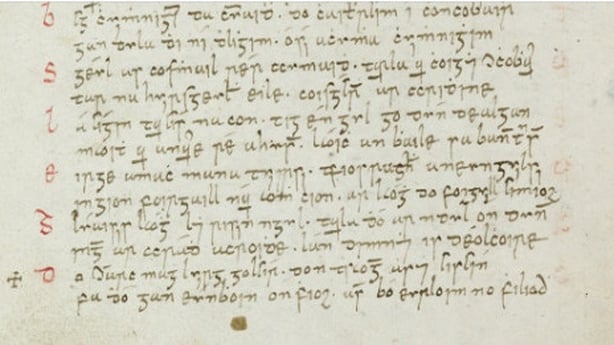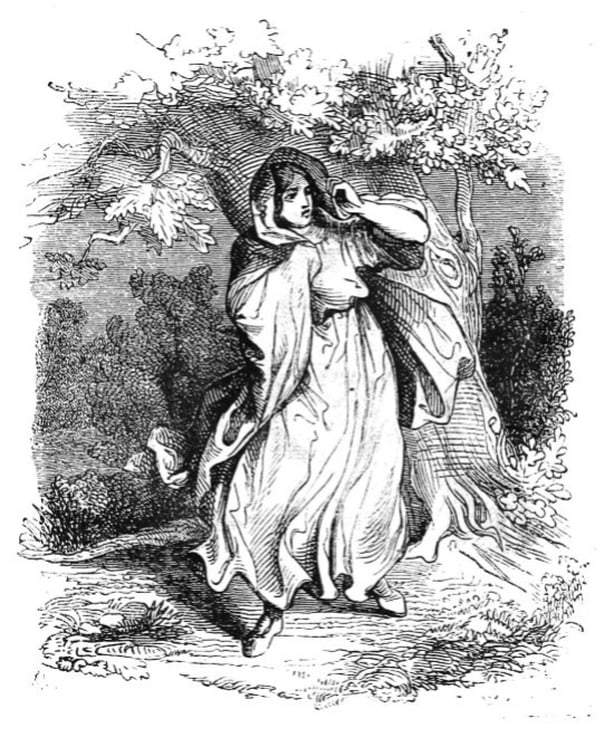Analysis: a 15th century poem preserves for us the tale of the lost daughter of one of our longest surviving heroes
Cú Chulainn may well be the best-known hero of Irish legend and literature. Like all heroes, there are many tales about his birth, life, superhuman deed, and death. In fact, the way he died will be familiar to anyone who has visited the GPO in Dublin where his final scene is depicted in a striking statue by Oliver Sheppard.
Sheppard’s sculpture is inspired by the story of Cú Chulainn’s death which is told in two versions. An older one, from around 800-900 AD, parts of which are now lost, and another, later version, possibly dating to around the 15th century, and surviving in over 100 manuscripts.
In the tale, Meadhbh, queen of Connacht, plots revenge against Cú Chulainn by allying with his enemies (of which there are many!). To make sure that Cú Chulainn will be killed, she also arranges special training in dark arts for the children of Cailitín, whose father Cú Chulainn killed in battle. Many ill omens precede Cú Chulainn’s death and it is prophesied that, if only he would wait for his comrade Conall Cearnach to return, he would live. (Conall is abroad at the time, but is soon to return to Ulster).
Apart from stray references in genealogical texts, the idea that Cú Chulainn had other children is not well established
Unable to resist the cry of battle and the humiliation of standing idly by while Meadhbh and her men lay waste to Ulster, Cú Chulainn’s people are ultimately powerless to stop him from entering the fray and he is mortally wounded. He asks to be tied to a pillar so his enemies will not realise he is dead. It is this scene that is immortalised in the statue in the GPO. Conall Cearnach hears of the death of his friend and returns to Ulster for revenge.
Another episode in this tale survives in a 15th-century poem. It gives an account of events after the death of Cú Chulainn that are not recorded anywhere else in Irish tradition. The poem was composed by Maol Eachlainn Ó hUiginn to mark the death of Eoghan Ó Conchobhair in 1444. This is an official elegy and the poet tells a story as part of his poem. This practice was not uncommon at the time, and such short stories, told as part of a longer poem, are known as apologues and were introduced to impart a message or make a comparison, much like the parables in the Bible.
We know from historical sources that the motive for killing Eoghan, like Cú Chulainn, was revenge. In an apt comparison, then, the poet draws a parallel between Eoghan’s death and that of Cú Chulainn: the grief of the people of Ulster, he tells us, was like that of Eoghan’s followers, and the poet’s own grief was like that of Cú Chulainn’s daughter.

Now, you may have heard of Cú Chulainn’s son, Conla, but probably not of his daughter. The Early Irish story of how Cú Chulainn fathered a son overseas and killed the boy in battle when he failed to recognise him is a well-known one. It provided the inspiration for the W. B. Yeats' poem Cuchulain's Fight with the Sea (1892) and his play On Baile's Strand (1903).
But apart from stray references in genealogical texts, the idea that Cú Chulainn had other children is not well established. Indeed, had the 15th century Ó hUiginn poem not survived (and only in a single manuscript copy at that!), his daughter, Bé Thuinne, would be otherwise unknown.
The poem tells her story, or part of it at least. It relates how Cú Chulainn’s daughter came to Ireland from overseas when she heard of his death. When she arrives, she gives out a lonely cry that is heard in Ulster. Cú Chulainn’s wife, Eimhear, sends the charioteer, Laogh, to investigate. Laogh meets the girl who reveals her identity and the whole province is engulfed by grief once again.

In keeping with his purpose, the poet draws a dramatic parallel between his own circumstances and those of Cú Chulainn’s daughter. When he heard the news that Eoghan Ó Conchobhair had been injured, he set off immediately on a journey of 100 miles from his home in Roscommon. It took him six days to reach Sligo and, on his arrival, he found that Eoghan had died the day before. The poet’s own journey mirrored that of Cú Chulainn’s daughter and the comparison evokes a sense of sorrow shared to great effect.
Since she is not mentioned elsewhere, we might well wonder if the poet has composed his own tale to suit his purpose or if he has preserved for us elements of a genuine tradition that have otherwise been lost. But there is good reason for thinking the latter (other comparisons, just as good, were available to him).
The appearance of Cú Chulainn's daughter, a solitary female figure, associated with death and weeping, may well call to mind one of the most familiar and widespread figures of Irish legend, the banshee. As recorded in oral tradition from the 19th century on, she has been described as 'a solitary, crying female supernatural being who is perceived as an ancestress of the family she attends’. The description is by Patricia Lysaght who was interviewed by Gay Byrne on the subject on The Late Late Show in 1986.
We need your consent to load this rte-player contentWe use rte-player to manage extra content that can set cookies on your device and collect data about your activity. Please review their details and accept them to load the content.Manage Preferences
From RTÉ Archives, folklorist Patricia Lysaght talks about the traditions, history and beliefs surrounding the banshee, the Irish harbinger of death
In earlier Irish literature, there are occasional references to two comparable figures and it has been argued that the banshee's origins lie in these. One is the supernatural woman who comes to mourn the death of a hero (as in the Old Irish tale Táin Bó Fraích or 'the Cattle Raid of Fráech'), the other is a washer woman at a ford who prophesies the hero’s death as he passes by.
Later, the figure of an otherworldly woman who mourns the death of historical leaders is common in Irish poetry from the 17th-century on, and particularly so in the 18th century. Aogán Ó Rathaille, for instance, depicts one such woman in a lament on the downfall of one of his patrons: Fíonscoth ag síorghol n-a haonar, / do chuir m’intleacht trí n-a chéile ‘Fíonscoth, weeping continually alone, has put my mind into confusion’.
Some 250 years older than Ó Rathaille’s work, Cú Chulainn’s daughter in the 15th-century Ó hUiginn poem is one of the earliest examples of a mythological mourner in an official lament of this kind and may well have inspired later poets. In her character, we also see resemblances to the banshee of later tradition. The poem is both an important strand in the development of one of the longest surviving figures of Irish mythology (the banshee) and also preserves for us a lost tale of the daughter of one of our longest surviving heroes.
A full study of the poem discussed in this article will be published later this year in volume 11 of the Studia Celtica Upsaliensia series
The views expressed here are those of the author and do not represent or reflect the views of RTÉ



